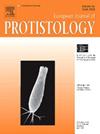Epiphytic and fimicolous myxomycetes on the island Hiddensee (Germany): rare species, new genotypes and unexpected ecological preferences
IF 1.6
2区 生物学
Q4 MICROBIOLOGY
引用次数: 0
Abstract
Hiddensee, a small island in the Baltic Sea, is characterized by a rather dry, windy, and sunny climate, resembling a periodic desert. We studied epiphytic and fimicolous myxomycetes on the island using the moist chamber method for 101 substrate samples. A total of 37 myxomycete species were identified from 124 records, including 4 species newly recorded in Germany. Molecular barcoding revealed that 67 % of the obtained DNA sequences were new, differing by more than 1 % from their closest matches in the GenBank database. We obtained the first molecular data for Didymium megalosporum (found to be related to the aethaloid species D. spongiosum and D. yulii) and C. elegans var. microspora (new data for both the species and the variety). For Trichia rapa, described in 2023 based on a single barcoded collection, we found three different ribotypes, including one already known. Presumably undescribed taxa within the morphospecies Comatricha nigra, Didymium squamulosum, Enerthenema papillatum, and Trichia contorta were identified by molecular barcoding. Substrate preferences of myxomycetes, categorized into four substrate types (bark of living trees, leaf litter, twigs, and dung), showed distinct patterns of occurrence, with each substrate type associated with a characteristic assemblage of myxomycetes. The species composition on the bark of living trees showed a well-known dependence on bark pH and hardness, with differing pH optima and tolerance ranges among the studied species. Echinostelium minutum occurred across a broad pH spectrum (6.1–8.0; 11 records), whereas Didymium leptotrichum was restricted to a narrow pH range (7.9–8.1; 7 records). Trichia munda preferred relatively acidic substrates (6.4–7.2; 9 records), while Perichaena luteola (7.4–8.0, 5 records) was more commonly found in slightly alkaline conditions.
德国Hiddensee岛上的附生和丝状黏菌:稀有物种,新基因型和意想不到的生态偏好
隐藏岛是波罗的海的一个小岛,其特点是气候干燥,多风,阳光充足,类似于周期性的沙漠。采用湿室法对岛上101个底物样品进行了附生和丝状黏菌的研究。124份记录共鉴定出黏菌37种,其中德国新记录4种。分子条形码显示,获得的DNA序列中有67%是新的,与GenBank数据库中最匹配的DNA序列差异超过1%。我们首次获得了巨孢Didymium megalosporum(发现与类乙烷物种D. spongiosum和D. yulii有亲缘关系)和秀丽隐杆线虫变种小孢子虫(C. elegans变种小孢子虫)的分子数据(种和变种均有新数据)。对于在2023年基于单一条形码收集描述的rapa,我们发现了三种不同的核型,其中包括一种已知的核型。利用分子条形码技术鉴定了形态种Comatricha nigra、Didymium squamulosum、enertheenema papillatum和Trichia contorta中可能未被描述的分类群。黏菌对基质的偏好分为四种基质类型(活树皮、落叶、树枝和粪便),它们的发生模式不同,每种基质类型都与黏菌的特征组合相关。活树树皮上的物种组成与树皮的pH值和硬度有关,不同物种的pH值最适值和耐受性不同。细棘球绦虫出现在广泛的pH范围内(6.1-8.0;11份记录),而Didymium leptotrichum则局限于较窄的pH范围(7.9 ~ 8.1;7记录)。褐毛霉偏爱相对酸性的底物(6.4-7.2;9条记录),而在微碱性条件下多见于木耳皮藻(7.0 ~ 8.0,5条记录)。
本文章由计算机程序翻译,如有差异,请以英文原文为准。
求助全文
约1分钟内获得全文
求助全文
来源期刊

European journal of protistology
生物-微生物学
CiteScore
4.60
自引率
20.70%
发文量
55
审稿时长
14.6 weeks
期刊介绍:
Articles deal with protists, unicellular organisms encountered free-living in various habitats or as parasites or used in basic research or applications. The European Journal of Protistology covers topics such as the structure and systematics of protists, their development, ecology, molecular biology and physiology. Beside publishing original articles the journal offers a forum for announcing scientific meetings. Reviews of recently published books are included as well. With its diversity of topics, the European Journal of Protistology is an essential source of information for every active protistologist and for biologists of various fields.
 求助内容:
求助内容: 应助结果提醒方式:
应助结果提醒方式:


